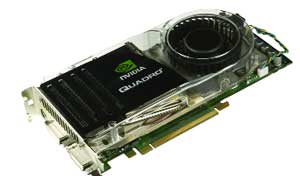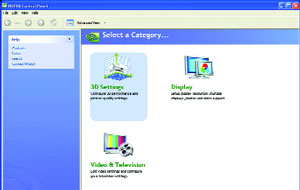New Graphics Power
We test the NVIDIA Quadro FX 4600 ultra high-end graphics board based on an all-new NVIDIA graphics processor.
We test the NVIDIA Quadro FX 4600 ultra high-end graphics board based on an all-new NVIDIA graphics processor.
December 4, 2001
By David Cohn
NVIDIA recently sent us its Quadro FX 4600, one of two new ultra high-end graphics cards announced in February. Both the FX 4600 and the even more powerful Quadro FX 5600 are based on NVIDIA’s new G80 GPU architecture, first introduced last November in the company’s GeForce 8800 GTS and GTX cards. Both of the new Quadro boards are targeted at high-end users who need interactive display of large, complex models, including automotive and aerospace design, oil and gas exploration, and scientific visualization.
 |
The new FX 4600 is the successor to the NVIDIA Quadro FX 4500, which we reviewed last year (see June 2006 DE), and offers significant improvements in capabilities and performance. For example, according to NVIDIA the Quadro FX 4600 offers up to 1.6 times performance improvement over the FX 4500.
Like its predecessor, the new Quadro FX 4600 has an ATX form factor, measuring 4.38 in. 3 9.0 in. The board plugs into a PCI Express X16 slot, and its maximum power consumption of 134 watts means that an auxiliary connection to the system power supply is also required. A large cooling fan and plastic cowl protrude more than an inch from the board, making it impossible to use the adjacent expansion slot.
On the output side, the Quadro FX 4600 provides two DVI-I display connectors, both with dual link capabilities, enabling the board to power two monitors. Analog resolution tops out at 2048 3 1536, while the board can power ultra-high-resolution digital displays at up to 2560 3 1600, or as high as 3840 3 2400 at 24/41 Hz refresh rates. There’s also a VESA stereo connector and both the FX 4600 and 5600 support the forthcoming version of NVIDIA’s Quadro G-Sync and SDI option cards, providing frame lock and broadcast-quality video capabilities, respectively. The new Quadro FX 4600 and 5600 are also the first professional graphics cards to offer support for HCP, which allows protected commercial HD DVD and Blu-Ray movies to be played back on a PC.
Like other high and ultra high-end NVIDIA boards, the FX 4600 also supports SLI, which lets users combine the power of two NVIDIA Quadro FX PCI Express graphics boards to improve the performance of a single application on a single display, run two applications simultaneously on two displays with each application having its own GPU, or drive four displays from one workstation.
Both the new FX 5600 and 4600 have a 384-bit memory width, compared to 256-bit in the older FX 5500 and 4500 that they replace. The new FX 4600 has 681 million transistors and comes with 768MB of onboard GDDR3 memory, yielding a memory bandwidth of 57.6 GBps. According to NVIDIA, the board delivers 250 million triangles per second and 12 billion texels per second. Like the other high-end boards in the NVIDIA lineup, the FX 4600 also features a 128-bit memory interface to maintain high accuracy and 12-bits sub-pixel precision.
The two new Quadro boards also support both OpenGL 2.1 and DirectX 10 with its new Shader Model 4.0, enabling complete hardware acceleration of even the very latest professional 3D graphics software, including those running on Microsoft’s new Vista operating system.
 NVIDIA’s new unified driver features a new control panel. |
New GPU Architecture
Perhaps the biggest news about the new FX 4600 and its sibling is the new G80 GPU unified core architecture. Previous generations of graphics cards had multiple pipelines — separate banks of vertex and pixel shaders that could only be used for accelerating vertex calculations and texturing, respectively. This often resulted in portions of the GPU sitting idle while others were maxed out.
The new G80 architecture does away with that, replacing it instead with a unified architecture that dynamically allocates the GPU’s power between vertex and pixel shading. This improves performance for all types of users. For example, games often utilize models with low numbers of polygons with lots of textures while CAD models often have large numbers of polygons with few or no textures. The unified architecture enables the processing power of the new graphics board to be dynamically allocated.
The NVIDIA Quadro FX 4600 GPU has an array of 96 parallel 1.20GHz processor cores. The GPU in the Quadro FX 5600 is even more powerful, with an array of 128 parallel 1.35GHz processor cores.
The new architecture is also a key part of NVIDIA’s new compute unified device architecture (CUDA) computing technology. Some types of computing tasks have parts that are better suited for CPU computing while other parts are better suited for being run on the GPU. CUDA provides a standard C language interface so that programmers can synchronize hybrid programs running on both CPUs and GPUs.
Impressive Results
To get a clearer picture of the power of NVIDIA’s new graphics accelerator, we performed our own benchmark tests on the Quadro FX 4600. We installed the new board in the same HP xw4200 workstation we’ve used to test every previous PCI Express workstation-class graphics accelerator. Although this computer is several generations old, using the same platform for all of our reviews enables readers to make a direct comparison of the benchmark results.
We did make one minor departure from our previous methods, however. In addition to running the same SPEC viewperf 8.1 test that we’ve used in the past, we also ran the newer viewperf 9.0, a more recent version of this synthetic benchmark. Both sets of results are provided in the accompanying table. For comparison, we list the viewperf 8.1 results for the other NVIDIA boards we reviewed last year.
Not surprisingly, the new NVIDIA Quadro FX 4600 outperformed both its FX 4500 predecessor and the former top-of-the-line FX 5500. Like all other professional workstation-class graphics accelerators from NVIDIA, the new Quadro FX 4600 is fully certified with most CAD and DCC applications and uses NVIDIA’s unified driver architecture (UDA). Drivers are available for Windows Vista and Windows XP (both 32- and 64-bit), Windows 2000 (32-bit only), Linux 32 and 64, and Solaris. The latest version of the driver adds support for the FX 4600 and 5600 and features a new control panel.
The NVIDIA Quadro FX 4600 is likely overkill for midrange CAD users. But those looking for the ultimate graphics power for design visualization will be well served by this new powerhouse. Just don’t expect to buy one directly from NVIDIA, because the Santa Clara-based company does not sell its products directly to end-users. Instead, its boards come bundled with a PC or are sold separately by selected resellers and VARs, such as PNY. While carrying a manufacturer’s suggested retail price of $2,399, a quick search turned up several vendors selling the FX 4600 for $2,049.
More Information
Requirements: PCI Express-based workstation with available x16 lane graphics slot; Microsoft Windows Vista (64-bit or 32-bit), Microsoft Windows XP (64-bit or 32-bit), Windows 2000 (32-bit), Linux (64-bit or 32-bit), or Solaris.
David Cohn is a computer consultant and technical writer based in Bellingham, WA, and has been benchmarking PCs since 1984. He’s a contributing editor to DE, an applications engineer with The PPI Group, and the author of more than a dozen books. Please send comments about this article here. You can also contact David at [email protected] or at dscohn.com.
Subscribe to our FREE magazine, FREE email newsletters or both!
Join over 90,000 engineering professionals who get fresh engineering news as soon as it is published.
About the Author
David Cohn is a consultant and technical writer based in Bellingham, WA, and has been benchmarking PCs since 1984. He is a Contributing Editor to Digital Engineering, the former senior content manager at 4D Technologies, and the author of more than a dozen books. Email at [email protected] or visit his website at www.dscohn.com.
Follow DE#9529
New & Noteworthy

New & Noteworthy: Safe, Cost-Effective Metal 3D Printing - Anywhere
Desktop Metal’s Studio System offers turnkey metal printing for prototypes and...

New & Noteworthy: Direct Neutronics Analysis on CAD
Coreform Cubit 2023.11 workflows enable neutronics directly on CAD for next-generation nuclear energy...

New & Noteworthy: Agile Engineering Collaboration
Authentise Threads is a new software tool for distributed communications and project...

New & Noteworthy Product Introduction: Enterprise VR Headset
Lenovo ThinkReality VRX has an immersive display works with virtual, augmented and...


